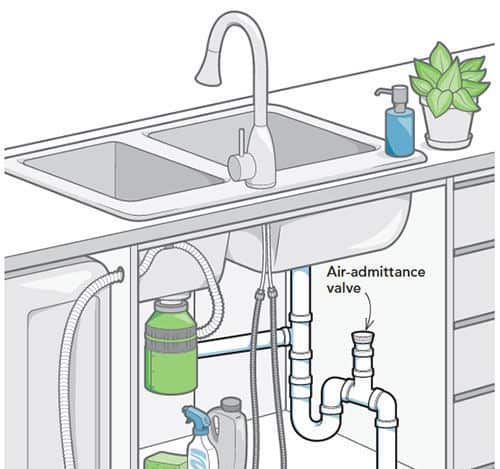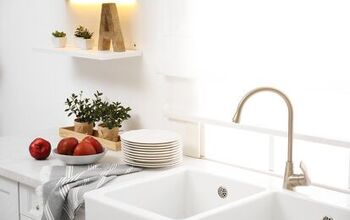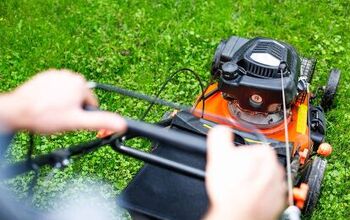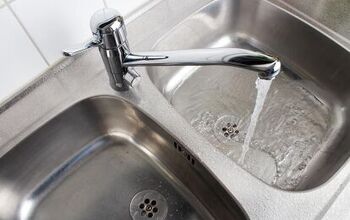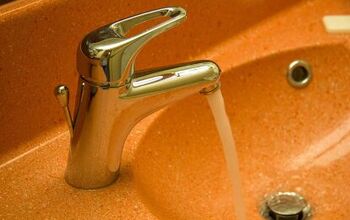How To Fix A Gurgling Kitchen Sink (Step-by-Step Guide)

One day you wake up and discover that when you flush your toilet, the kitchen sink starts gurgling. Or maybe the kitchen sink gurgles when the water goes down. Your kitchen sink gets more use than any other faucet in your house, so this is typically where you end up noticing the issue. But the problem may have started somewhere else.
Clean your roof vent with a drain snake or air admittance valve near the P-trap if your kitchen sink gurgles. Carefully clean the P-trap with a drain snake or wire pipe cleaner if there is a clog or debris. Make sure that your kitchen vent is 3 ½ feet away from the P-trap, and adjust it to stop the gurgling sound if it isn’t.
Do You Need to Hire a Plumber?
Get free, zero-commitment quotes from pro contractors near you.

Find the Cause to Fix the Problem
The best way to fix a gurgling sink is to find out the cause of it first. Most people immediately think it is a food or debris clog, so they grab some Drano or Liquid-Plumr and start pouring. Don’t do that. The gurgling you hear is your sink telling you that something is wrong. Listen to it and take steps to figure out what is going on before calling in the pros.
Take a Look at Your P-Trap
The p-trap is there to keep air and gases from your home. It is supposed to always have water in it, which is why it is shaped to look like a “P.” The water is a barrier for keeping the gasses out of your house while also keeping the sink draining properly.
Your p-trap must have enough water in it at all times to help the water flow and block gases. If your p-trap does not have water in it, you will need to flush the system. Flush your pipes with running water for two or three minutes to clear your drain system.
Check the Sink Vent
If the gurgling sound only happens when you turn on the kitchen sink, the issue is most likely caused by the sink vent. It could be that the vent is too far from the lower part of the p-trap.
Your vent should be 3½ feet or less from the lower part of the p-trap. Having the vent too far away could cause a vacuum, which will make the gurgling sound. If the vent is too close, you will need an extension to make the pipe longer.
It May Be Your Roof Vent
The roof vent (or main vent) is a pipe sticking out of the roof of your home. It is there to release gases and provides air movement in the pipes. Every time you turn on the water or flush the toilet in your home, the water pushes the air from the empty pipes. That air has to go somewhere. If your roof vent is clogged, the bubbling will occur because the air is coming out of your sink instead.
To clean out this vent, you have to get on top of your house with a hose or a plumber’s snake. This can be a dangerous job if you do not know what you are doing. It may be best to call in an expert. If you are going to do it yourself, though, make sure you wear a harness to keep from falling off the roof.
If You Do Not Have a Roof Vent
If you cannot find a roof vent on your home, you may have an air admittance valve instead. This will be a straight pipe going up from between your p-trap and the wall pipe with a valve on top of it.
This valve is commonly used if the homeowner did not want a roof vent in the home. It provides air release, so the air pressure does not build up in your pipes and allows gases to escape. Check to be sure it is not clogged or dirty. You may need to clean it out or replace it.
Look for Debris or Clogs in the Pipes
If your pipes are not getting enough air, the water will flow slower and cause bubbling or gurgling in the sink as well. This could be caused by a buildup of dirt or food in the p-trap. You will need to clean out the p-trap to fix the problem. Here are the steps to cleaning the p-trap.
Step One: Gather Your Tools
To do this properly, you will need a few basic tools. Some of these basics include:
- Gloves
- Bucket
- Wrench
- Pliers
- Wire pipe cleaner
- Plumbing snake
Step Two: Removing the P-Trap
Make sure you are wearing gloves to protect your hands. With the bucket underneath the p-trap to catch the water, unscrew the coupling nuts to release the p-trap. If these are too tight, you can use the wrench or pliers.
Step Three: Cleaning Out the P-Trap
Remove any hair, food, or other solid debris you can see. If you cannot see anything, use the wire brush to scrub the inside of the p-trap. It may be that you have a buildup of dirt, slime, or mold in the p-trap.
Step Four: Snaking the Drain
Use your plumbing snake to clean out the drainpipe that goes into your wall. It may be that the clog is in that pipe somewhere. Run the snake as far as it will go and work it in and out several times.
Step Five: Reassembling the P-Trap
After you have cleaned and snaked both pipes, put the p-trap back and tighten the coupling nuts to secure the p-trap. Make sure you put it back the way it was. The long end goes into the sink drain.
Do You Need to Hire a Plumber?
Get free, zero-commitment quotes from pro contractors near you.

Related Questions
What if None of These Steps Work?
If you have done all the above steps and your sink is still gurgling, you may have a more serious problem with your plumbing. It could be a clogged or broken garbage disposal. If you have a septic tank rather than using the city sewer system, your problem may also be a clogged or damaged septic system.These types of issues typically require a professional. Unless you are a plumber, you probably do not want to try working on your own septic system. In fact, if you try to clean out your own septic system you could do more damage than good.
What if My Water Drains Slow?
Slow draining could be any of the above issues as well. Or it could be that an excessive amount of water from rain or snow has caused a backup in your main vent or septic system. The problem may be a flooded drain field in your septic system from too much rain.
Septic System Facts
Having a septic system instead of using city sewer lines can be a blessing or a curse, depending on how well your system is built and if you take care of it properly. You should also know how your septic system works.
Important Tip: Your septic system uses bacteria to clean your water so do not pour chemicals into the toilet.The way a septic system works is to collect all the wastewater from your home and then treat it by separating the solids from the clear water. The water then goes through your drain field under the soil in your yard to treat it and let it dissipate.You should have your tank pumped every three to five years depending on how many people live in the house and how large your septic tank is. And never flush wipes, feminine hygiene products, diapers, or other things that are not biodegradable.

I am a DIYer who loves writing about anything home-related. When I am not writing, you can find me studying for my PhD in Psychology, photographing nature, and swimming at the lake with my grandkids.
More by Patricia Oelze




